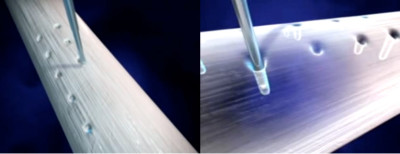Achilles-tendinitis is a condition in which there is inflammation of the Achilles tendon.

It causes pain at the back of the ankle where the Achilles tendon joins the heel bone. It arises from overuse and strain on the limbs. The Achilles tendon has a poor blood supply and if the tendinitis is left untreated and the inflammation is allowed to progress, then the chance of an Achilles tendon rupture increases. This ankle pain condition commonly affects athletes (especially runners) and middle-aged patients.
Physical Examination for Achilles Tendinitis
During the consultation, our foot specialist will look for certain signs during the examination of your foot and ankle. These signs include:
- A swelling observed at the back of the heel.
- The affected area will have maximum tenderness.
- In non-insertional tendonitis, there is tenderness at the middle of the tendon.
- In insertional tendinitis, there is tenderness at the point where the tendon joins the heel bone.
- There is a limited range in the ankle movement. This makes it hard and painful for one to flex their muscles, especially during activity.
Tests for Achilles Tendinitis
The diagnosis of Achilles tendinitis is largely clinical. In some situations, we might do some imaging tests such as these:
- X- rays: They will show if calcification has occurred at the lower portion of the tendon and this is an indication of insertional Achilles tendinitis. In many cases of severe non-insertional Achilles tendonitis, calcification may also occur in the central portion of the tendon.
- MRI scan (magnetic resonance imaging): in severe and chronic cases of Achilles tendinitis, it would be wise to do a scan to rule out partial tears of the tendon and other associated injuries.
Achilles Tendon Surgery
Achilles tendon surgery is the last resort and only considered after failure of 6 months of non-surgical tendinitis treatment. The type of surgery that your foot specialist in Singapore does for you depends on the extent of injury:
- Debridement and repair (tendon has less than 50% damage). In this ankle surgery, the damaged part of the tendon is removed; once this is done, the healthy portion of the tendon is repaired with stitches. With insertional tendonitis, the spur is also removed; metal anchors may be required in these cases, to hold the tendon in the place where it attaches to the heel.
- Debridement with tendon transfer (tendon has greater than 50% damage). If damage to the Achilles tendon is greater than 50%, this requires removal during the tendon surgery. The remaining portion of the tendon will not be strong enough to support your body weight and an additional procedure is required. Tendons which help your big toes point down are transferred to where the heel bone is, to help improve strength in the area. This transferred tendon takes over the function of the removed portion of Achilles tendon.
- TOPAZ is a quick, simple and minimally invasive medical technique now available for the treatment of chronic tendon problems. The TOPAZ MicroDebrider is designed specifically to treat tendons and fascia and it utilizes patented Coblation® technology. The TOPAZ technique has been associated with a quick return to daily activities. This tendon surgery typically takes less than 20 minutes to administer. This can be done under local anaesthesia and light sedation and patients can go home about 1-2 hours after the procedure.

Looking For A Reliable Foot & Ankle Orthopaedic Specialist?
Fast Medical Attention, Transparent Fees
Make an appointment for comprehensive care for your Foot & Ankle problems!
